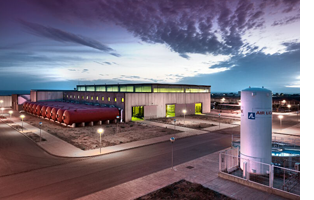DesalData Weekly - November 4, 2015
Posted 04 November, 2015 by Mandy

In the Middle East, the intergovernmental political and economic union known as the Gulf Cooperation Council (GCC) is set to increase its desalination capacity by 40% within the next five years, in order to meet the region’s growing demand for drinking water. GCC member states—Bahrain, Kuwait, Oman, Qatar, Saudi Arabia, and the United Arab Emirates—currently use around 3,300 million Imperial gallons of potable per day (MIGD; 15 million m³/d) and this number is expected to increase to 5,200 MIGD by 2020 (23 million m³/d).
According to data produced by MEED Projects (a Middle East and North Africa projects tracker): “While reserve margins between supply and demand appear to be at comfortable levels, at country and local network levels the supply-demand gaps are much smaller.”
Desalination plant in Almeria, Spain Credit: Abengoa Press Room
[1][2] For instance, while Qatar and the UAE have had good reserve margins in the past several years, Saudi Arabia, Oman, and Kuwait have had great difficulty meeting the demand for potable water, in particular, during warmer, drier summer months.
Over the last ten years, the member states of the Gulf Cooperation Council have invested $76 billion in water projects. They are expected to expend similarly massive amounts of cash to develop their collective desalination capacity depending on the future of commodities prices. Future investments, however, will mark a break from the past—in order to promote the development of reverse osmosis membrane technology, rather than the more traditionally popular and energy-intensive methods of thermal distillation.[3]
In southern Spain, Veolia Water Technologies has started up one of Europe’s largest desalination plants. The facility, known as the Campo Dalías desalination plant, will supply 50,000 cubic metres of desalinated water per day to a population of 300,000 people and it will enable the irrigation of 8,000 hectares of land in the Almería province of Andalusia.[4] The plant will allow the area’s aquifers to regenerate.
The Spanish Ministry for Agriculture, Food, and Environment has promoted the facility, which Veolia has designed and built at a cost of 130 million Euros ($144 million). In more numbers: the plant’s massive operational capabilities are enabled by 12,810 membranes, 41 kilometres of pipelines, 730 control instruments, and more than 3,000 pieces of electromechanical equipment.[5] On a daily basis, the output of freshwater is equivalent to filling 47 Olympic swimming pools.
[1] “GCC to Increase Desalination Capacity by 40%,” October 28, 2015, Out-Law.com, <http://www.out-law.com/en/articles/2015/october/gcc-to-increase-desalination-capacity-by-40/> accessed November 3, 2015.
[2] “GCC to Increase Desalination Capacity 40% by 2020, IWS Reveals,” October 26, 2015, Zawya, <https://www.zawya.com/story/GCC_to_increase_desalination_capacity_40_by_2020_IWS-ZAWYA20151026083036/> accessed November 3, 2015.
[3] Ibid.
[4] “Veolia Starts up €130m Campo Dalías desalination plant,” November 2, 2015, Filtration & Separation, <http://www.filtsep.com/view/43158/veolia-starts-up-130m-campo-dal-as-desalination-plant/> accessed November 3, 2015.
[5] “Veolia Starts up Campo Dalias Desalination Plant,” October 27, 2015, Environmental Leader, <http://www.environmentalleader.com/2015/10/27/veolia-starts-up-campo-dalias-desalination-plant/> accessed November 3, 2015.
